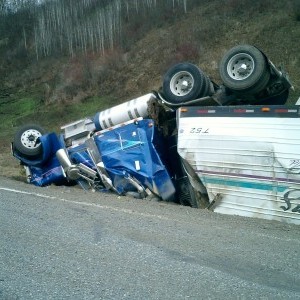In a recent study of over 240 trucking rollover accidents across the country, the Federal Motor Carrier Safety Administration states that most rollover crashes are due to driver errors that could be prevented. When trucking rollover accidents occur, truck injury lawyers commonly see serious injuries and fatalities to truck drivers, as well as drivers and passengers in automobiles.
Why Do Trucks Roll Over in a Crash?
According to studies by the Federal Motor Carrier Safety Administration, most trucking rollover accidents are caused by truck driver errors. In-depth analysis of accident statistics show:
- Almost one-half of trucking rollover accidents result from failure to adjust speed around curves. When a truck enters a curve, it leans away from the direction of the curve due to centrifugal force. At a high speed, the result is often a rollover where the truck overturns. Due to the high center of gravity and instability, tractor-trailers are particularly vulnerable.
- The second leading cause of truck rollovers is overloaded cargo. Loads are a frequent problem when drivers fail to take account of cargo weight, height and loading procedures, or trucks are loaded before drivers are assigned routes. Rollovers are often caused by top heavy and badly distributed or unsecured loads.
- The third leading cause of truck rollovers is lack of driver attention to the road. Inattentiveness is often due to distractions within the truck, emotional and physical impairments, and drivers dozing or falling asleep behind the wheel. Truck injury lawyerssee many serious trucking accidents caused by driver fatigue.
- The fourth leading cause of truck rollovers involves problems with steering, braking and tires. Many rollover accidents occur when truck drivers don’t control steering properly to stay in a lane, over-steer to avoid lane changes, and over-correct steering to remain on the road. Poorly maintained braking systems and under-inflated tires also cause numerous rollover accidents.
According to accident statistics, the Federal Motor Carrier Safety Administration concluded that truck rollovers are among the deadliest types of trucking accidents. Studies show that the majority of these accidents are caused by truck driver errors which are often completely preventable.
Injuries Caused by Truck Rollover Accidents
When a truck rollover accident occurs, injuries normally affect five main areas of the body – the head and neck, thorax, abdomen, upper limbs and lower limbs. The majority of rollover crash victims sustain multiple injuries throughout these body regions with the head and neck being the most vulnerable area. Some of the most common rollover injuries seen by truck injury lawyers include traumatic head and brain injuries, spinal cord injuries, limb amputations, and broken bones and fractures. These types of injuries are commonly caused from slamming into another vehicle or obstacle, impact with unsecured cargo, contact with broken glass or torn metal, being tossed around within the vehicle, or ejected from the vehicle due to the impact of the crash.
Truck rollover accidents often result in serious injuries and fatalities to everyone involved in the accident. Many accident victims who survive often suffer long-term injuries and chronic pain. The long term effects of rollover injuries can include impairment of critical functions such as speech, vision and memory; emotional and physical disabilities; partial vision loss or blindness; hearing loss; dental injuries and loss of teeth; chronic back pain; amputation or the arms or legs; and a variety of internal damages to nerves, veins, and organs.
Preventing Truck Rollovers
Overcoming the three biggest causes of rollovers, speed, overloading and inattention, present many challenges for the trucking industry. Unfortunately, many truck drivers learn about the causes of rollover accidents by failing to recognize dangerous situations and experiencing rollover crashes first hand. Some crashes might be avoided with roadway changes such as signs that require lower speeds at freeway exits, and vehicle changes like devices that warn truck drivers of dangerous load conditions. However, related costs for these safety measures are significant.
A more affordable solution to reducing truck rollover accidents includes training programs for drivers that discuss rollover prevention measures, especially in large tractor-trailers that are vulnerable to rollovers. Studies show that 69 percent of truck rollover accidents involve tractor-trailers, although the number of registered single-unit trucks on U.S. roadways outnumbers tractor-trailers by nearly three to one.
In recent years, numerous video programs on trucking safety have been developed for the trucking industry with hopes to prevent truck rollover accidents and injuries seen so often by truck injury lawyers. Since statistics show that most truck rollover accidents are the fault of the truck driver, trucking companies often bear significant costs for related injuries. To reduce those liabilities, many trucking companies are focused on improving driver awareness on the causes of rollovers and preventing future accidents. Some companies have developed simulation videos where drivers are presented with rollover situations, then experience the consequences and learn how to safely handle them.

